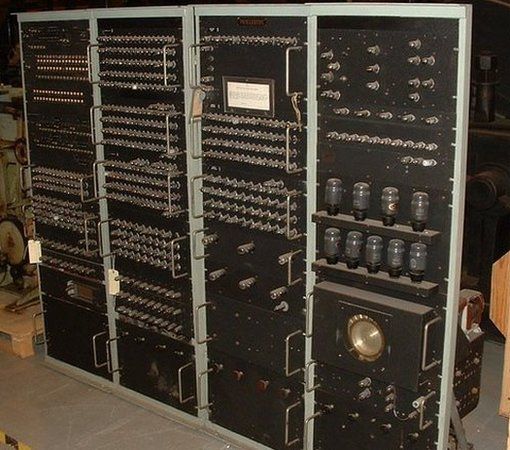From punch cards to smartphones
- Published

After World War II, Britain was a hotbed of pioneering computer research. Work done on automatic ways to crack codes and spot enemy aircraft meant it had a skilled cadre of engineers and scientists equipped with the knowledge to create powerful and practical computers.
The machines that resulted, the Manchester Mark I, Edsac and the Ace, are now well known. Even Colossus, a secret during wartime and for decades after, is now widely recognised as the world's first programmable, electronic digital computer.
But not all the UK's pioneers and pioneering computers are as well-known. This week The National Museum of Computing in Bletchley Park is putting on display one machine, the HEC-1, that was recently discovered in the stores of the Birmingham Museums Trust. It was very popular and successful in its day but is poorly appreciated today.
This is ironic in the case of its creator Dr Andrew Booth because, said Dr Roger Johnson, one of the innovations he came up with is ubiquitous today more than 60 years after it was invented.
The innovation is the Booth multiplier that helps to speed up some types of calculation performed by a central processing unit in a computer as it handles data.
"There are hundreds of them in a smartphone," said Dr Johnson. "In any chip that has a multiplier, the overwhelming majority will be a Booth multiplier."
Design trip
Nothing that Edsac creator Maurice Wilkes worked on, nor anything that Tom Kilburn and Freddie Williams in Manchester created has had such a lasting impact, said Dr Johnson who has spent years uncovering and compiling information about Dr Andrew Booth's work.
Booth started as a crystallographer at Birkbeck College and turned to automatic calculating machines to help do the complex maths involved in this work. Through his boss at Birkbeck, JD Bernal, he got a six-month Rockefeller Scholarship to Princeton which he spent time talking to computer pioneer John Von Neumann.
"In my view Booth did two key things," said Dr Roger Johnson, a computer scientist turned computer conservationist, "One is the multiplier, the other is that he was the first person to connect a rotating storage device successfully to a computer and read and write data."
In fact, he said, Dr Booth got perilously close to creating the first floppy disk. Unfortunately the disks he tried to adapt for his fledgling computer, paper coated with magnetic oxide used in an early dictating machine, proved too floppy. They deformed at the 3000 RPM he needed to spin them - making it impossible to read and write data to them.
Instead, said Dr Johnson, he invented magnetic drum storage that used a small brass drum coated with nickel. It was a world first and the original is now on display in the UK's Science Museum.
Both these innovations found a place in the small computers Booth built - the most significant of which was the All Purpose Electronic Computer (APEC).
Good fit
The first version of APEC was built in a barn at the Booth family home in Fenny Compton, Warwickshire.
Raymond "Dickie" Bird has clear memories of the place, the man and the machine.
"The barn was falling to bits," Dr Bird told the BBC. "It was so rotten that the legs of the chairs we sat on sank in to the woodworm-eaten floor and it was as cold as hell."
Mr Bird and two colleagues were in Fenny Compton to copy the design of the APEC for the British Tabulating Machine Company which was keen to produce a computer of its own.
BTM was a market leader in punch card machines but, said Dr Bird, also had a prescient eye on the future.
"They saw the threat early on to their vast market for punch card machines that computers posed," he said. As a result it was in the market for a computer of its own and Dr Booth's fit the bill because it was small, relatively cheap, fit for business use and could be manufactured in large numbers.
By contrast, said Dr Bird, the other machines being produced in the early 1950s were usually too big, expensive and specialised for most of BTM's customers.
Not so with Dr Booth's machine.
"He wanted a tabulator to use as input and output to the machine he had got and in return he would give out the plans for the computer," he said.
The penny-pinching philosophy of Booth senior had rubbed off on his son, said Dr Bird, and was reflected in the APEC's design. Though, said Dr Bird, to be fair this approach was borne out of necessity as much as habit.
"Andrew Booth was a very economical man," said Dr Bird. "If something could be done with half a valve rather than one, he did it."
"He worked with no support from anyone else and designed computers, little ones, to work in his lab," he said.
"I took his basic circuits and the core of his logic and built a machine called HEC 1," said Dr Bird. "I engineered it to be manufacturable and serviceable."
"It was a reliable, low cost machine that could go by the hundreds into business," said Dr Bird. "And it did for we sold more than 100 of the Booth-derived machines."
- Published6 March 2016
- Published7 December 2015
- Published29 June 2015
- Published3 February 2015